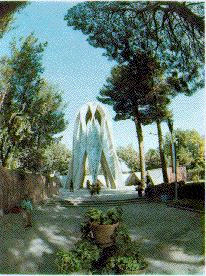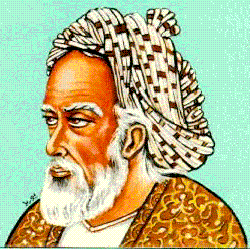|
Neyshabur (Nishapur)
 Neyshabur
is located in 115 kms. west of Mashhad in the province of Khorasan,
Iran. Neyshabur
is located in 115 kms. west of Mashhad in the province of Khorasan,
Iran.
This ancient city has been the home of the great poet and mathematician Hakim Omar-e-Khayyam
and the great mystical poet Attar-e Neyshaburi..

The tomb of the great iranian artsist Kamaal Al-Molk is in Neyshabur, too.In
addition, Neyshabur has been a major source of Firouz-e (Turquoise)
for thousands of years and still a major center of Turquoise trade.
Hakim Omar-e-Khayyam - (b. May 18, 1048,
Nishapur, Iran -- d. Dec. 4, 1131, Nishapur)
Khayyam was a Persian poet, mathematician, and astronomer, renowned in his own
country and time for his scientific achievements but known to English-speaking  readers for his roba'iyat ("quatrains") in the version The Rubáiyát of Omar Khayyám,
published in 1859 by Edward FitzGerald (q.v.).
readers for his roba'iyat ("quatrains") in the version The Rubáiyát of Omar Khayyám,
published in 1859 by Edward FitzGerald (q.v.).
He discovered a geometrical method to solve cubic equations by intersecting a
parabola with a circle.
His work on algebra was known throughout Europe in the Middle Ages, and he also contributed to calendar reform. Cowell quotes The Calcutta Review No 59:
When the Malik Shah determined to reform the calendar, Omar was one of the eight learned men employed to do it; the result was the Jalali era (so called from Jalal-ud-din, one of the king's names) - 'a computation of time,' says Gibbon, 'which surpasses the Julian, and approaches the accuracy of the Gregorian style.'
Khayyam measured the length of the year as 365.24219858156 days. Two
comments on this result.
Firstly it shows an incredible confidence to attempt to give the result
to this degree of accuracy. We know now that the length of the years is
changing in the sixth decimal place over a person's lifetime. Secondly
it is outstandingly accurate. For comparison the length of the year at
the end of the 19th century was 365.242196 days, while today it is
365.242190 days.
In his algebra book, Khayyam refers to another work of his which is now lost.
In the lost work Khayyam discusses Pascal's triangle but he was not the first to do so since the Chinese may have discussed Pascal's triangle slightly before this date.
The algebra of Khayyam is geometrical, solving linear and quadratic equations by methods
appearing in Euclid's Elements . Khayyam discovered a geometrical method to solve cubic equations. He did this by intersecting a parabola
with a circle but, at least in part, these methods had been described by earlier authors
such as Abu al-Jud.
Khayyam also gave important results on ratios giving a new definition and extending
Euclid's work to include the multiplication of ratios. He poses the question of whether a ratio can
be regarded as a number but leaves the question unanswered.
His name Khayyam ("Tentmaker") may have been derived from his father's trade. He received a
good education in the sciences and philosophy in his native Neyshabur (Nishapur) and in Balkh and
then went to Samarkand, where he completed an important treatise on algebra. He made such a name
for himself that he was invited by the Seljuq sultan [Index] Malik-Shah to undertake the astronomical
observations necessary for the reform of the calendar. He was also commissioned to build an
observatory in the city of Esfahan in collaboration with other astronomers. After the death of his
patron in 1092, Omar went on a pilgrimage to Mecca. Returning to Neyshabur he taught and served
the court from time to time by predicting events to come. Philosophy, jurisprudence, history,
mathematics, medicine, and astronomy are among the subjects mastered by this brilliant man.
Unfortunately, few of his prose writings survive; these include a  few brief tracts on metaphysics and
a treatise on Euclid. few brief tracts on metaphysics and
a treatise on Euclid. He was in his time as famous as his contemporaries Avicenna and Hassan-e
Sabah., mainly for the writing of many scientific treatises. Hundreds of
Rubaiyat are today attributed to Omar Khayyam. many are deemed apocryphal but 72
certified authentic Rubaiyat are collected in the book The Wine of Nishapur
- Poems by Omar Khayyam.
Khayam Related Web Sites
Attar-e Neyshaburi
Farid Od-din Attar Neyshaburi was one of the greatest muslim mystical poets and thinkers of the 12th century.
He has written at least 45,000 distichs (couplets) and many brilliant prose works.
Attar travelled extensively, visiting egypt, syria, arabia, india and central
asia and finally settled in his native town neishabour, northeastern iran, where
he spent many years collecting the verses and sayings of famous muslim mystics.

The greatest of his works is his well-known 'manteq ot-teyr' (the conference of the birds), which is an
allegorical poem describing the quest of the birds. his other works include 'elahinameh' (divine book).
From the point of view of ideas, literary themes and style, attar's influence was
strongly felt not in persian literature but in other islamic literatures.
His grand book of Tazakor-ol-Oliah is in prose and his most famous works in verse
include:
Asrarnameh, Elahinameh, Mosibatnameh, Manteq-u'ttair, Bulbulnameh, Heydarnameh, Mokhtarnameh
and Khosrownameh among which Mantegh-u'ttair is unrivaled in mastery and composition.
Manteq-u-ttair or the Conference of Birds, sung in iambic hexameter, is an
elegantly versified book.
Following Solomon's tradition the poet puts tongue in the mouths of the birds
and enables them to warble his theme and fly high and high towards Mount Ghaf in
search of the invincible Simorgh or Phoenix which he ascribes to the Almighty
God, and by this metaphor Attar brings his episode to a surprising climax. Led
by the unwavering hoopoe or Hod Hod, thirty birds out of many thousands manage
to cross the seven fatal valleys in the Path and arrive at the majestic court of
the Prince of Universe on the verge of annihilation.
What they see in amazement there is an enormous phantom mirror of a thousand molten planets which reflects their own shapes and purified selfs. Here they dissolve in the mirror and join the enternity.
The poet opens the conference by praising hoopoe, Solomon's herald
and other chosen birds each representing a mystic metaphor: Hail to you,
oh hoopoe, our nimble guide, A messenger that at ev'ry bower fly and
glide, Bid by King Solomon to far Sheba you were gone (Solomon to whom
the language of birds was known); You hold Solomon's diadem on your
head, And converted the Queen of Sheba to his faith.
|